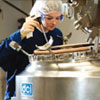Certipur
Proteins are used in routine laboratory procedures such as binding enzymes or coupling peptides to carrier proteins. These kits, mixture solutions, and collagen matrices fulfill a myriad of essential laboratory functions for developing relationships between proteins and other cellular components. The stimulating proteins offered have various amino acid arrangements and functions to fulfill any sample manipulation for testing purposes in any field.
Numéro de catalogue:
(PRSI92-125)
Fournisseur:
ProSci Inc.
Description:
DnaJ Homolog Subfamily B Member 1 (DNAJB1) is a member of the heat shock protein family. Heat shock proteins (HSPs) are a highly conserved family of stress response proteins. HSPs function primarily as molecular chaperones, facilitating the folding of other cellular proteins, preventing protein aggregation, or targeting improperly folded proteins to specific degradative pathways. DNAJB1 regulates cellular processes by aiding in the folding, transport and assembly. DNAJB1 contains a J-domain which controls interaction with the ATPase domain of DnaK. DNAJB1 interacts with HSP70 and can stimulate its ATPase activity. In addition, DNAJB1 stimulates the association between HSC70 and HIP.
UOM:
1 * 50 µG
Numéro de catalogue:
(PRSI96-574)
Fournisseur:
ProSci Inc.
Description:
CD200 is also known as OX-2 membrane glycoprotein (OX-2), is a type-1 membrane glycoprotein, which contains two immunoglobulin domains (1 Ig-like C2-type (immunoglobulin-like) domain and Ig-like V-type (immunoglobulin-like) domain), and thus belongs to the immunoglobulin superfamily. CD200 / OX-2 is widely expressed in multiple cell types. CD200 interacts with a structurally related receptor (CD200R) expressed mainly on myeloid cells and is involved in regulation of macrophage and mast cell function. OX-2 / CD200 and CD200R associate via their respective N-terminal Ig-like domains. CD200 also plays an important role in prevention of graft rejection, autoimmune diseases and spontaneous abortion.
UOM:
1 * 1 EA
Numéro de catalogue:
(PRSI96-597)
Fournisseur:
ProSci Inc.
Description:
Programmed cell death protein 1 (PD-1) is also known as CD279 and PDCD1, is a type I membrane protein and is a member of the extended CD28/CTLA-4 family of T cell regulators. PDCD1 is expressed on the surface of activated T cells, B cells, macrophages, myeloid cells and a subset of thymocytes. PD-1 has two ligands, PD-L1 and PD-L2, which are members of the B7 family. PD-L1 is expressed on almost all murine tumor cell lines, including PA1 myeloma, P815 mastocytoma, and B16 melanoma upon treatment with IFN-γ. PD-L2 expression is more restricted and is expressed mainly by DCs and a few tumor lines. PD1 inhibits the T-cell proliferation and production of related cytokines including IL-1, IL-4, IL-10 and IFN-γ by suppressing the activation and transduction of PI3K/AKT pathway. In addition, coligation of PD1 inhibits BCR-mediating signal by dephosphorylating key signal transducer. In vitro, treatment of anti-CD3 stimulated T cells with PD-L1-Ig results in reduced T cell proliferation and IFN-γ secretion. Monoclonal antibodies targeting PD-1 that boost the immune system are being developed for the treatment of cancer.
UOM:
1 * 1 EA
Numéro de catalogue:
(PRSI92-348)
Fournisseur:
ProSci Inc.
Description:
Neuritin-like protein belongs to the neuritin family. Neuritin is a GPI-anchored protein that promotes neurite outgrowth and branching of neuritic processes in primary hippocampal and cortical cells. Neuritin expression also enhances the development of motor neuron axon arbors by promoting neuromuscular synaptogenesis and by stimulating the addition of new axon branches. Neuritin is induced by neuronal activity and by the neurotrophins, BDNF and NT3. NRN1L contains a consensus cleavage signal found in glycosylphoshatidylinositol (GPI)-anchored proteins.
UOM:
1 * 50 µG
Numéro de catalogue:
(PRSI92-359)
Fournisseur:
ProSci Inc.
Description:
EGFR is a transmembrane glycoprotein that is a member of the protein kinase superfamily. This protein is a receptor for members of the epidermal growth factor family. EGFR is a cell surface protein that binds to epidermal growth factor. Binding of the protein to a ligand induces receptor dimerisation and tyrosine autophosphorylation and leads to cell proliferation. Activates at least 4 major downstream signalling cascades including the RAS-RAF-MEK-ERK, PI3 kinase-AKT, PLCgamma-PKC and STATs modules. May also activate the NF-kappa-B signalling cascade. Also directly phosphorylates other proteins like RGS16, activating its GTPase activity and probably couplling the EGF receptor signalling to the G protein-coupled receptor signalling.
UOM:
1 * 50 µG
Numéro de catalogue:
(PRSI92-361)
Fournisseur:
ProSci Inc.
Description:
CD40 Ligand (CD40LG) is a type II transmembrane glycoprotein that belongs to the TNF superfamily. Like other TNF superfamily members, CD40LG exists as a trimer in membrane bound and soluble form, both of which are bioactive. CD40LG is a ligand for CD40; its ligation also initiates signal transduction in CD40LG expressing cells. CD40LG is a differentiation antigen that is expressed on the surface of T-cells. It stimulates B-cell proliferation and secretion of all immunoglobulin isotypes in the presence of cytokines. CD40LG has been shown to induce cytokine production and tumouricidal activity in peripheral blood monocytes. It also co-stimulates proliferation of activated T-cells and this is accompanied by the production of IFN-gamma, TNF-alpha, and IL2.
UOM:
1 * 50 µG
Numéro de catalogue:
(PRSI91-630)
Fournisseur:
ProSci Inc.
Description:
Sialic acid-binding Ig-like lectin 9(Siglec 9) is expressed by peripheral blood leukocytes (neutrophils and monocytes but not eosinophils), and found in liver, fetal liver, bone marrow, placenta, spleen and in lower levels in skeletal muscle, fetal brain and so on. It is a putative adhesion molecule that mediates sialic-acid dependent binding to cells. It also binds to alpha-2,3- or alpha-2,6-linked sialic acid. The sialic acid recognition site may be masked by cis interactions with sialic acids on the same cell surface.
UOM:
1 * 50 µG
Numéro de catalogue:
(PRSI91-633)
Fournisseur:
ProSci Inc.
Description:
platelet receptor Gi24 is a single-pass type I membrane protein, and located at the cell surface. The protein can be cleaved by MMP14, and stimulate MMP14-mediated MMP2 activation. It is participated in the BMP signaling pathway. It also regulates the CD4-pasitive, alpha-beta T cell proliferation, and T cell cytokine production negatively. However, the protein can regulate stem cell differentiation positively.
UOM:
1 * 50 µG
Numéro de catalogue:
(PRSI90-304)
Fournisseur:
ProSci Inc.
Description:
Irisin is a recently described exercise-induced hormone secreted by skeletal muscle in mice and humans. Irisin activates beige fat cells (beige cells have a gene expression pattern distinct from either white or brown fat and are preferentially sensitive to the polypeptide hormone irisin). Irisin is cleaved from the type I membrane protein FNDC5 and improves systemic metabolism by increasing energy expenditure. FNDC4 is an ortholog of FNDC5 with 50% identity and 86% similarity compared to Irisin. FNDC4 as well as FNDC5 are extremely well conserved between species. The function of FNDC4 is unknown. The human FNDC4 gene is highly enriched in liver, brain tissue and adipocytes.
UOM:
1 * 1 EA
Numéro de catalogue:
(PRSI91-700)
Fournisseur:
ProSci Inc.
Description:
Vitamin D-Binding Protein (DBP) is a member of the ALB/AFP/VDB family. DBP is a secreted protein and contains three albumin domains. The primary structure contains 28 cysteine residues forming multiple disulfide bonds. DBP acts as a multifunctional protein found in plasma, ascitic fluid, cerebrospinal fluid, and urine and on the surface of many cell types. DBP binds to vitamin D and its plasma metabolites and transports them to target tissues. DBP associates with membrane-bound immunoglobulin on the surface of B-lymphocytes and with IgG Fc receptor on the membranes of T-lymphocytes.
UOM:
1 * 50 µG
Numéro de catalogue:
(PRSI91-706)
Fournisseur:
ProSci Inc.
Description:
Leucine-Rich Repeat Transmembrane Protein FLRT3 (FLRT3) is a member of the fibronectin leucine rich transmembrane protein (FLRT) family. Proteins in this family play an role in cell adhesion and/or receptor signalling. FLRT3 is a single-pass type I membrane protein and contains one fibronectin type-III domain, ten LRR (leucine-rich) repeats, one LRRCT domain, and one LRRNT domain. FLRT3 may have a function in cell adhesion and/or receptor signaling. FLRT3 may regulate cellular adhesion between the epithelial apical ridge and the underlying mesenchyme and in establishing the dorso-ventral position of the ridge.
UOM:
1 * 50 µG
Numéro de catalogue:
(PRSI90-535)
Fournisseur:
ProSci Inc.
Description:
Interleukin-35 (IL-35) is a novel IL-12 family cytokine produced by regulatory T cells (Treg) but not by resting or activated effector T cells (Teff). IL-35 is a heterodimeric protein composed of EBI3 (Epstein-Barr-Virus-induced gene 3) and IL-12a (p35). EBI3 is a downstream target of Foxp3, a transcription factor required for Treg-cell development and function, and thus Treg-cell restriction of IL35 occurs. Regulatory T cells are essential for maintaining self tolerance and preventing autoimmunity, and IL-35 is identified as a molecule that mediates the immune suppression function of Treg-cell. As an inhibitory cytokine, IL-35 induces proliferation of Treg-cell populations but suppresses Th17 cell development. Studies in mice show the absence of either IL-35 chain from Treg-cell reduces the cells' ability to suppress inflammation using an experimental model for inflammatory bowel disease. IL-35 is suggested as a potential target of immunotherapy.
UOM:
1 * 25 µG
Numéro de catalogue:
(PRSI91-532)
Fournisseur:
ProSci Inc.
Description:
Chemokine (C-X-C motif) Ligand 1 Protein (CXCL1) is a growth factor for melanoma cells and a chemotaxin for neutrophils and a member of the CXC chemokine family that is a potent neutrophil attractant and activator and is also active toward basophils. CXCL1 is expressed by macrophages, neutrophils and epithelial cells; it has neutrophil chemoattractant activity. CXCL1 plays a critical nonredundant role in the development of experimental Lyme arthritis and carditis via CXCR2-mediated recruitment of neutrophils into the site of infection and may also have important pro-nociceptive effects via its direct actions on sensory neurons, and may induce long-term changes that involve protein synthesis.
UOM:
1 * 50 µG
Numéro de catalogue:
(PRSI91-291)
Fournisseur:
ProSci Inc.
Description:
CD200 is a transmembrane immunoregulatory protein that belongs to the immunoglobulin superfamily. It contains one Ig like V type domain and one Ig like C2 type domain in its extracelluar domain. CD200 is widely but not ubiquitously expressed. Its receptor (CD200R) is restricted primarily to mast cells, basophils, macrophages, and dendritic cells, which suggests myeloid cell regulation as the major function of CD200. CD200 and CD200R associate via their respective N-terminal Ig-like domains. In myeloid cells, CD200R initiates inhibitory signals following receptor-ligand contact. In T cells, CD200 functions as a co-stimulatory molecule independent of the CD28 pathway. In addition, CD200 also plays an important role in prevention of graft rejection, autoimmune diseases and spontaneous abortion.
UOM:
1 * 50 µG
Numéro de catalogue:
(PRSI91-286)
Fournisseur:
ProSci Inc.
Description:
ICAM-2 is a 55-65 kD transmembrane glycoprotein possessing 2 extracellular Ig domains, a single transmembrane domain, and a short 26-amino acid cytoplasmic domain. ICAM-2 is expressed on most leukocytes, and is strongly expressed on vascular endothelial cells. Interactions of ICAM-2 and the integrin receptors mediate cell adhesion in a wide range of lymphocyte, monocyte, natural killer cell, and granulocytewith other cells, and play important roles in many adhesion-dependent immune and inflammation responses, such as T cell aggregation, NK-cell cytotoxicity and migration, lymphocyte recirculation, etc. Serum levels of ICAM-2 correlated significantly with the inflammatory and course sequences of trichinosis in mice and had a similar relation with blood eosinophilia. So, estimation of ICAM-2 serum levels may prove useful in diagnosis of trichinosis recent infections, and in monitoring the prognosis and response to treatment.
UOM:
1 * 50 µG
Numéro de catalogue:
(PRSI91-284)
Fournisseur:
ProSci Inc.
Description:
C1QTNF1 is a secreted protein,contains 1 C1q domain and 1 collagen-like domain. C1qTNF proteins constitute a highly conserved family of Acrp30/Adiponectin paralogs that share a modular organization comprising an N-terminal signal peptide, a short variable region, a collagenous domain and a C-terminal globular domain. C1qTNF proteins are predicted to have trimeric structures that assemble into hexameric and higher order molecular forms. C1QTNF1 is a novel adipokine, providing a significant framework to further address the physiological functions and mechanisms of the action of this family of secreted glycoproteins in normal and disease states. C1QTNF1 increases the production of aldosterone. C1QTNF1 is vastly expressed in obese subjects as well as up-regulated in hypertensive patients, C1QTNF1 is identified molecular link between obesity and hypertension. C1QTNF1 expression may be associated with a low-grade chronic inflammation status in adipose tissues.
UOM:
1 * 50 µG
Appel de prix
Le stock de cet article est limité mais peut être disponible dans un entrepôt proche de vous. Merci de vous assurer que vous êtes connecté sur le site afin que le stock disponible soit affiché. Si l'
Le stock de cet article est limité mais peut être disponible dans un entrepôt proche de vous. Merci de vous assurer que vous êtes connecté sur le site afin que le stock disponible soit affiché. Si l'
Ces articles ne peuvent être ajoutés au Panier. Veuillez contacter votre service client ou envoyer un e-mail à vwr.be@vwr.com
Une documentation supplémentaire peut être nécessaire pour l'achat de cet article. Un représentant de VWR vous contactera si nécessaire.
Ce produit a été bloqué par votre organisation. Contacter votre service d'achat pour plus d'informations.
Le produit original n'est plus disponible. Le remplacement représenté est disponible
Les produits marqués de ce symbole ne seront bientôt plus disponibles - vente jusqu'à épuisement de stock. Des alternatives peuvent être disponibles en recherchant le code article VWR indiqué ci-dessus. Si vous avez besoin d'une assistance supplémentaire, veuillez contacter notre Service Clientèle au 016 385 011.
|
|||||||||||||||
















































